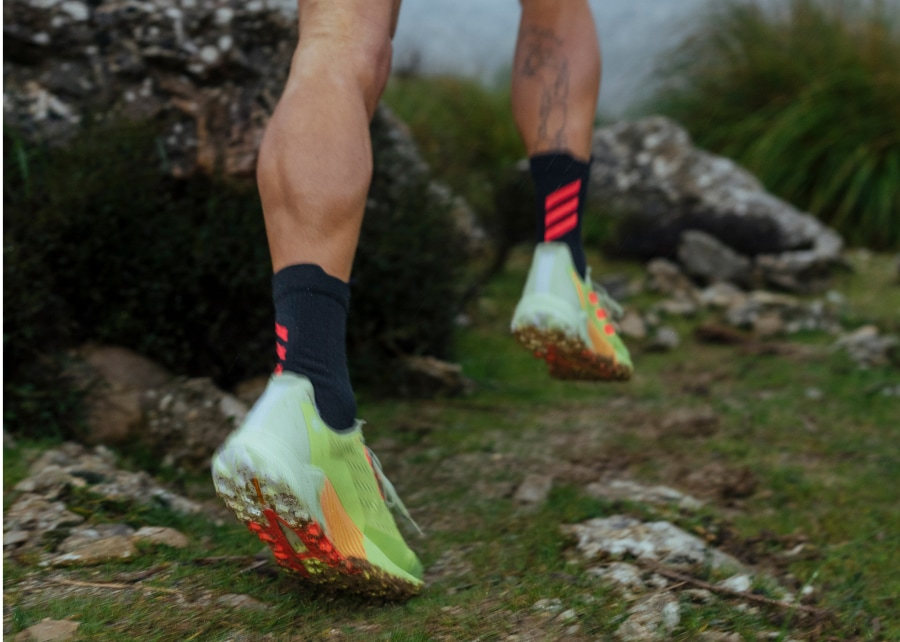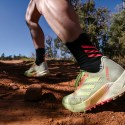It’s well before dawn as I swing open the door to my Prius and step into the near-empty parking lot at the base of Chautauqua Park in Boulder, Colorado. Though I’m five minutes early for our bi-weekly 5:45am run, I hustle across the pavement to catch up to Leah, my dear friend and more-than-punctual running buddy, who’s already moving toward the First Flatiron trailhead. We start over the familiar stretch of hard-packed dirt to where the trail narrows into rock-strewn singletrack and make our way up. It’s 1,446 feet of elevation over the 1.4 miles to the top. As our feet cover the varied terrain, our conversation spills into family affairs: first-day-of-school victories and too-true “the kids are growing up so fast!” cliché.
We don’t pause for long at the summit; there’s work and “real life” to return to–but as we descend the switchbacks, I glance up at the sun peeking pink over the horizon and feel grateful for a new day, a good friend and the luxury of running the trail before the daunting tasks of the day commence. And yet this blessing is a blip: It feels like no time at all has passed before we’re back at the trailhead.
Even with a busy day ahead, I (and many of the runners I know) love outings like that, where poof the miles just … disappear. Too often I praise the scenery or the conversation for facilitating these lost-in-the-moment bipedal pursuits. But the shoes that carried me through the run, working so seamlessly I forget I’m in them, deserve a good bit of credit. I’ve had that experience more times than I can count–while ascending, descending and traversing a wide range of terrain–with the adidas Terrex Agravic Flow 2, which is why they’ve become my shoe of choice over the past months.
One shoe to rule them all
I’m not the only one who’s been relying on these trailblazers of late. Professional ultra-distance trail runner Abby Hall—who’s earned second place finishes at elite races like the 2021 Courmayeur-Champex-Chamonix (part of the Ultra-Trail du Mont-Blanc series) and the 2022 Transgrancanaria in the Canary Islands—also reaches for the Agravic Flow 2. Hall, an adidas-sponsored athlete, often encounters a mix of rocks, soft dirt and even stretches of gravel or pavement all on a single run and appreciates the seamless way the shoe handles anything the trail dishes out. “It’s important as a trail runner to feel prepared for a variety of scenarios and conditions,” Hall says, which is why “it quickly became my go-to TERREX shoe.”

Hall may be a very different type of runner than I am–she’s fast, I’m a turtle; she laughs in the face of 20-mile training runs while I feel the burn if I go much farther than my neighborhood 10-kilometer route. But the versatile Agravic Flow 2 covers our diverging needs.
That’s exactly what it was designed to do. “We wanted to bring a trusted feeling on technical terrain to a wider audience,” says Niklas Benzer, senior product manager for TERREX, adidas’ outdoor-focused sub-brand. “For a lot of athletes, the Agravic Flow 2 might be more of a training shoe because there are more specialized, lighter shoes for races. But in the end, the Agravic Flow 2 is a great shoe for the everyday runner to do most of their miles.”
That said, shoes in the Agravic line have crossed many a finish line. Hall herself turned to the original Agravic Flow in 2020 when she set out for an unsupported (Read: No help from anyone along the route) Fastest Known Time (FKT) attempt through the Sierra Nevada mountains on the Nüümü Poyo, also known as the John Muir Trail. Aware that she would be traversing 220 miles across everything from buttery smooth dirt to boulder fields–and preferring to reserve premium space in her pack for cashew milk yogurt and Tailwind sports fuel, not extra shoes–she chose a “quiver killer” that would hold up no matter what the trail threw her way.
“We wanted to bring a trusted feeling on technical terrain to a wider audience.”
– Niklas Benzer, senior product manager, adidas TERREX
Hall says that using the Agravic Flow 2 for a multi-day FKT attempt speaks to “how versatile they are” on a variety of trails. “Being an ultrarunner, you don’t want to put on a shoe that feels like the equivalent of high heels where it’s fussy, or you’ve got to get the lacing just right. I want to put on a shoe that feels familiar, that feels easy.” For Hall, the Agravic is “ready for anything.”
For fellow ultrarunner Taylor Nowlin, “anything” meant the 100-mile Western States Endurance Run. In what to some was an unexpected move, the decorated ultrarunner changed out of her standard race shoe, the adidas TERREX Speed Ultra, at the second aid station. Her feet had started to swell, and she knew she needed to go a half size up. Enter the Agravic Flow. The shoes carried Nowlin to a seventh-place finish in the women’s division, 22 overall. “I train in both, so I knew either would work,” she says. “I actually took the Flows off one of my crew member’s feet, which was definitely not planned!”
Hall adds that a shoe’s familiarity is important come race day. “Having a deep relationship with gear that you’ve gotten to know in training is something that can be really valuable on race day,” she says. “It’s something that’s tried and true. The same things that would make it a good training shoe, is in some ways, what makes it a good racing shoe.”
The origin story of an outdoor powerhouse
Witnessing the signature three-stripe logo crossing the finish line near the front of the pack at elite races might be surprising for an American audience that perceives adidas as a soccer brand with a knack for monochromatic tracksuits and sneakerhead-worthy Stan Smiths. That’s a rather narrow lens for what data analytics website Statistica reports to be the largest sportswear manufacturer in Europe, second only to Nike worldwide. Forbes lists its 2021 revenue at $22.6 billion.
In the late 1970s, adidas created a lightweight approach shoe for legendary mountaineer Reinhold Messner, the first person to summit Mount Everest without supplemental oxygen.
While that number includes adidas’ myriad forays into everything from soccer to hockey (they’re an official outfitter for both women’s FIFA World Cup soccer and the NHL)—not to mention high-fashion ventures like the Yeezy collab with Kanye West—the multi-billion-dollar figure also encompasses adidas TERREX, whose roots go back nearly 50 years.
In the late 1970s, adidas created a lightweight approach shoe for legendary mountaineer Reinhold Messner, the first person to summit Mount Everest without supplemental oxygen. The innovations developed for those shoes were foundational to what, in 2007, expanded into a full lineup of outdoor-focused footwear and apparel marketed under the name adidas Outdoor. Four years later, the Outdoor sub-brand introduced TERREX to the U.S. market.
When trail running gained a foothold in the outdoor space in the early 2010s, adidas was primed to be a key player. “Before [trail running], it was just about moving fast in the mountains,” adidas’ Benzer says. “And that’s where we came from.”

Introducing the Agravic
Given that history in fast-trekking shoes, introducing the “lighter and runnable” Agravic line in 2015 was a natural progression, Benzer says.
The newest member of that collection, the Agravic Flow 2, updates the time-tested technologies built into the original Agravic Flow model. It retains the grippy Continental rubber outsole–complete with a lug pattern versatile enough to facilitate confidence on uneven, rocky sections without feeling overly clunky on stretches of pavement. Now, however, the shoe has a Lightstrike EVA foam midsole for an even, “flowy” feeling across varying terrain and a Pro-Moderator full-length rock protection plate. The re-engineered mesh upper enhances airflow and is made with recycled plastic materials, a partnership with environmental organization Parley for the Oceans. And it doesn’t hurt that the Agravic Flow 2 comes with an approachable price tag ($140 for the men’s, $160 for the women’s).
All of these features combine to form a shoe ready for any type of trail. “It sounds weird to say purpose-built for versatility,” Hall says, “but that’s kind of what it is. [The Flow 2] is purpose-built to be used for a variety of purposes.”

A skeptic might see the Agravic Flow 2’s versatility as a weakness. And sure, someone who trail runs only on technical, scree-covered trails or always in muddy conditions might find a beefier, lugged-out shoe to better fit their specific needs. Likewise, the pros might choose a lighter-weight pair of kicks like the adidas Terrex Speed Ultra (just 210 grams!) for days when they’re toeing the start line. (Though, as Hall and Nowlin show, there are notable exceptions.)
“The Agravic Flow 2 is not this crazy super shoe that makes you 4% faster,” Benzer says. Instead, it lets the user stress less over their shoe choice. “You just go out and know you can handle everything that comes in these shoes.”
Driving 15 minutes home after my early-morning run, I start making a mental to-do list for the day: pack the school lunch, interview an influential athlete, tame days of research and reflection into a personal essay. I feel a bit overwhelmed. And it makes me that much more grateful for the time on the trail, when just as Hall and Benzer promised, I felt like I was ready for anything.


